First flying animals (and III): Acrobatic aerial lovers
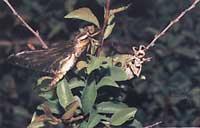
The newly configured dentist after the emergency is sexually immature. For example, coloration and brightness are lacking in adults. The moment the wings harden enough, it will turn on the water in which the development of the larva has occurred. This first flight occurs at dawn, after the animal has reached an adequate indoor temperature by the effect of the wings, before the bird can hunt. This first flight is usually a few meters, like most witches, or it can become a long trip, as many txitxiburduntzis do.
Due to this first flight, immature dentists sexually move away from the sphere of action of male assets, and thus can feed and develop fully without interference. Maturity can be reached between two and three days after emergence in some species or, at the other end, for three weeks in some aniopterans. However, the return to the shores is a sign of a newly reached maturity. The duration of the ripening process is variable, although it is usually shorter than in the skewers and longer in females than in males.
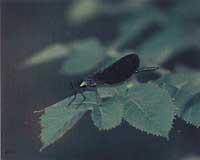
When they arrive faster, males usually reach reproductive areas before females, where they show territorial behaviors. That is, each animal will defend an area, that is, the territory, and will try to expel from it the rest of the “penetrating” males. Territoriality is related to the achievement of the couple and, apparently, hunting, since the territory is, in short, a hunting area.
The owner of a territory approaches flying to any interior, both of the same species and of the same species, and is abandoned to his side. Then, and if the female is of the species, he will try to equate it. If not, hit the inside with the backrest and both owners and bombers fight together in flight to knock down otherwise. These fights are usually of short duration and the result is usually to distance the farmer. In cases where the owner is already in possession, his territorial response usually consists of the presence of ritualized aggressive kilimusis or reverences, such as showing significantly the colored abdomen, other stereotyped movements, etc.
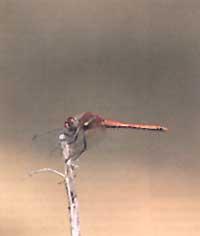
The size and limits of the territory are very variable, depending on the conditions of each specific place. In any case, sunstroke and plant scarcity are apparently the main selection factors used by dentists. Likewise, the surface of the defended territory is a direct function of the size of the odonate species, so that a small well resides in a single male txitxiburduntzi of the genera Anax or Aeshna, on whose banks are preserved dozens of sterile.
On the other hand, this surface has been correlated with two other factors. On the one hand, with the distance in which the odonee can see the movement and, on the other, with the density of the males. In fact, as density increases, the surface of the territories decreases, until with a certain density the minimum territory is reached (never less than a square meter). The maximum density or, which is the same, the minimum territory, are specific peculiarities, but the smaller the species, the higher the maximum density.
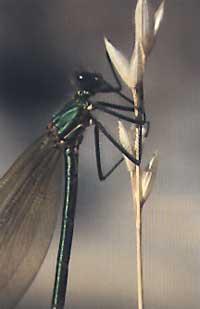
On the other hand, to avoid interspecific conflicts, the territories of the different species can be divided into zones, both vertical and horizontal, so that some species appear preferably on the water bank, other upstream, some in the center of the swamp, etc. It is also necessary to mention what is normally defended in short periods of time, that is, that a certain male will prevail for a short term in a specific area, but that later he will be aware of several territories. Thus, it is often difficult to define the concrete limitations of the territory. However, the most successful males are not those who triumph in the same territory at most, but those who own the females when they reach it.
Adult dentists can divide them into two groups, “flyers” and “verifiers” in general. The first fly to hunt, and travel the territory in search of hunting. On the contrary, the verifying species are located in points with a wide panorama, as in the tip of a reed, from where the whole territory is controlled. If we accept the simple classification mentioned, we will include the skewers in the flying group and the sorcerers in the checkers group, with exceptions. As we know, adult dentists are predators that feed on live hunting. In the case of verifying species, once the sorceress detects the prey from the site it goes towards it, it acquires it with legs and jaws and returns to the place where it eats. In flying species, both attack and hunting are carried out in flight. However, if the size of the prey is large, which does not usually happen, the prank will rest so that the food is cooked.
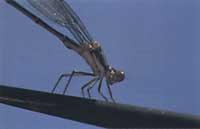
Feeding dentists are not aggressive, despite their sexual maturity. Therefore, sometimes large altars or sets of odonates can appear in places with abundant prey, such as clouds of ants or flying termites. They are quite opportunistic and the only limit of the diet is the size of the prey. In the case of txitxiburduntzis, diptera, mosquitoes and water mosquitoes, efemeras, tricopters, and, with more difficulty, butterflies, bees and other dentists have been observed. They say that tropical anioptera can catch them more daring, as well as small frogs and even hummingbirds. Since most sorceries are smaller in size, loops and more astirous flights, they have also resorted to feeding on fixed insects, such as plants, which extract them from the vegetation.
As already explained on an earlier occasion, adult odonates capture their prey through the eye, with the eyes well adjusted to detect movements. In fact, large species can separate movements at twenty meters. The anisoptera (= txitxiburduntziak) have a single small binocular zone in their visual field, and probably do not use binocular vision to calculate the distance to the prey in flight, but the binocular zone of the zigoptera, that is, of the witches, is wider, so they can separate the prey against a complex background, such as the hostage.
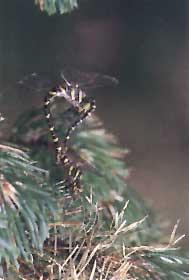
As for reproductive behavior, it can be said that it is extremely shocking, since in some respects it is totally different from other insects: on the one hand, for its territorialist behavior, as we have seen, and on the other hand, for its secondary reproductive apparatus (along with the acrobatic copulation that forces it) and for the sperm competition. We will analyze these points immediately.
It seems that the males of the dentists know how to recognize the females as females, without confusing them with their prey. For this purpose they use the colors and transparency of the wings of the cooked female. After being known, the narcotics of the genera Calopteryx and Platycnemis start in courtship kilimuses. However, courtship is not common among dentists. When a female of these genera moves through the territory of the male to which it belongs, the owner posing will turn the abdomen upwards, showing its colouring at the bottom. And the answer of an aiduru or anxious female is to stand next, starting to turn around this male.
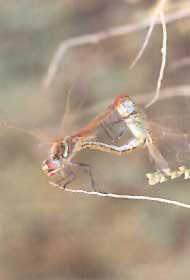
The way dentists touch is unique among insects and speaks clearly of the primitivity of this group. The primary reproductive device of the male is located in the posterior segments of the abdomen, as in the other insects. However, male dentists have a secondary reproductive device in the second and third abdominal segment. The secondary apparatus Ugal is used as an interior organ during copulation to transfer sperm.
Due to the secondary Ugal apparatus, a lot of speculation has been published. To understand the nature of this apparatus, we need an evolutionary look. The first insects were fin, as were the current collemboli and silver fish. In this type of insects it does not exist, and it is believed that in the ancestors there was no contact between male and female reproductive devices. Instead, sperm is stored in a protein box, sperm, and deposited in the soil until females are found.
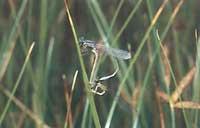
In the case of odonates there is also no contact between the primary reproductive devices of males and females, unlike the other flying insects. Male odonates, instead of leaving sperm in the soil, place sperm in the secondary reproductive device of the second abdominal segment, which is the structure that will be internalized throughout the coulation. That is, although current dentists do not produce spermatophore, it is believed that their ancestors had it: the male would leave the spermatophore on the ground and later the female would take it with the abdominal end, while maintaining the abdominal end of the male from the chest to show the female the way to the spermatophore. Therefore, the “tandem” that we will expose in the next paragraph appeared before the secondary player. In the next evolutionary step, as could not be otherwise, the male left the spermatoforum in his own abdomen, being received by the female. Finally, in the front of the male's abdomen, sperm could penetrate the female as a secondary reproductive device. Hypothesis, all this is yet to be demonstrated.
The copulative behavior sequence develops in the same way as explained below. First, the male will follow the females aerated on the water or, as already said, will act in a circular dance. Then the male supported by the rear abdominal appendages holds the female by the same, forming a tandem. Thus, the male turns the abdomen ventrally with himself, displacing the sperm from the genital opening of the ninth segment to the secondary reproductive apparatus of the secondary segment.
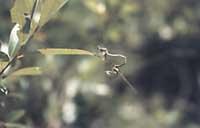
In most known cases this exchange is done before the tandem is formed, the whole operation is very fast. Finally the copulation itself begins. For this, the male tilts the abdomen upwards, while the female sends his forward to link it with the secondary copulating organ of the second abdominal segment of the male. All these stunts outline a heart figure.
The pair of dentists raised in copulation is extremely vulnerable. Therefore, it could be thought that natural selection has driven short copulations. However, its duration is very variable and in some species are very long. As for the latter, there is an explanation that deserves some lines. The phenomenon is known as “sperm competition” and has been seen in the narcotics of the genus Calopteryx. The copulating male excretes sperm from the rest of the previous males before transferring their own sperm from the female.

The female fertilizes the last males. That is, if the male is hooked to the female for a long time, somehow it is ensuring the laying of the eggs fertilized by her, since to another leaves less and less chances of copulation. Hence the reason for long copulations. Selective advantages of the “last is first” type are common among some insects, but active excretion of sperm has only been seen in dentists using the copulating organ.
Buletina
Bidali zure helbide elektronikoa eta jaso asteroko buletina zure sarrera-ontzian











